限定词的搭配关系及相互位置
- 格式:doc
- 大小:39.50 KB
- 文档页数:6

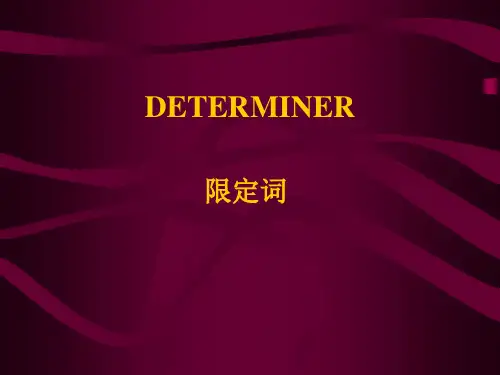
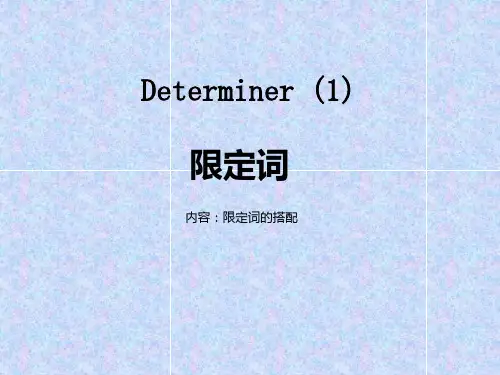

限定词:限定词是在名词词组中对名词中心词起特指、类指以及表示确定数量和非确定数量等限定作用的词类。
名词词组除有词汇意义外,还有其所指意义,是特指(即指特写的对象),还是类指(即泛指一类人或物〕;是有确定的数量,还是没有确定的数量。
能在名词词组中表示这种所指意义的词类就是限定词。
基本简介1、冠词(article)定冠词(DEFINITE ARTICLE),不定冠词(INDEFINITE ARTICLE),零冠词(ZERO ARTICLE)2、形容词性的代词物主限定词(POSSESSIVE PRONOUN DETERMINER),my, your, his, her, our, your, their, one's, its.名词属格(GENITIVE NOUN),John's, my friend's.指示限定词(DEMONSTRATIVE DETERMINER),this, that, these, those, such.关系限定词(RELATIVE DETERMINER),whose, which.疑问限定词(INTERROGATIVE DETERMINER),what, which, whose.不定限定词(INDEFINITE DETERMINER),no, some, any, each, every, enough, either, neither, all, both, half, several, many, much, (a) few, (a) little, other, another.3、数词(numeral)基数词(CARDINAL NUMERAL) 和序数词(ORDINAL NUMERAL)倍数词(MULTIPLICATIVE NUMERAL) 和分数词(FRACTIONAL NUMERAL)4、量词(QUANTIFIER) a lot of, lots of, plenty of, a great of, a good deal of,a large of, a small amount of, a quantity of, a great of, a good n umber of等。
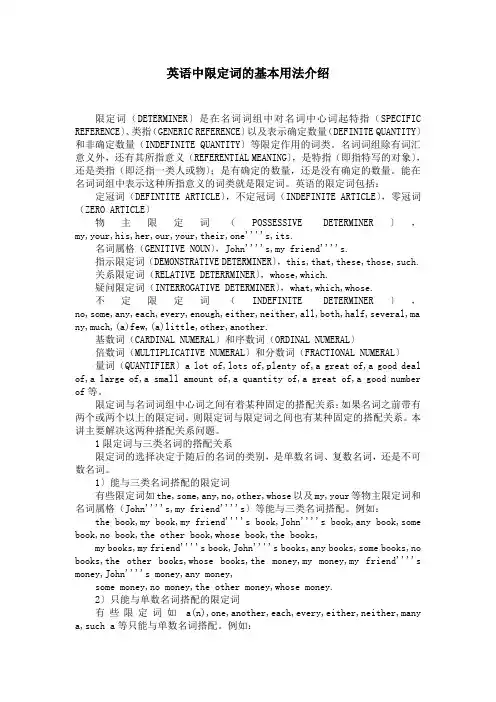
英语中限定词的基本用法介绍限定词(DETERMINER〕是在名词词组中对名词中心词起特指(SPECIFIC REFERENCE〕、类指(GENERIC REFERENCE〕以及表示确定数量(DEFINITE QUANTITY〕和非确定数量(INDEFINITE QUANTITY〕等限定作用的词类。
名词词组除有词汇意义外,还有其所指意义(REFERENTIAL MEANING〕,是特指(即指特写的对象〕,还是类指(即泛指一类人或物〕;是有确定的数量,还是没有确定的数量。
能在名词词组中表示这种所指意义的词类就是限定词。
英语的限定词包括:定冠词(DEFINTITE ARTICLE〕,不定冠词(INDEFINITE ARTICLE〕,零冠词(ZERO ARTICLE〕物主限定词(POSSESSIVE DETERMINER〕,my,your,his,her,our,your,their,one''''s,its.名词属格(GENITIVE NOUN〕,John''''s,my friend''''s.指示限定词(DEMONSTRATIVE DETERMINER〕,this,that,these,those,such.关系限定词(RELATIVE DETERRMINER〕,whose,which.疑问限定词(INTERROGATIVE DETERMINER〕,what,which,whose.不定限定词(INDEFINITE DETERMINER〕,no,some,any,each,every,enough,either,neither,all,both,half,several,ma ny,much,(a)few,(a)little,other,another.基数词(CARDINAL NUMERAL〕和序数词(ORDINAL NUMERAL〕倍数词(MULTIPLICATIVE NUMERAL〕和分数词(FRACTIONAL NUMERAL〕量词(QUANTIFIER〕a lot of,lots of,plenty of,a great of,a good deal of,a large of,a small amount of,a quantity of,a great of,a good number of等。

限定词顺序口诀及解析前位限定词:such,what,half,both,all百分比,分(数),倍(数)属前位水火不容,避同现中位限定词:中位阵容很庞大形容词性物主代,冠词,名词格,指示代,连词,不定限定词包括哪些要记清同时出现有条件巧用of来转换后位限定词:序数与类序基数与量数先序后基可共存量词在基后面跟量词与名词紧相邻形影不离不拆散(1)前位限定词包括:①不定限定词(Indefinite determiner)all,both,half②倍数词(Multiplicative numeral)double,twice,three times,etc.③分数词(Fractional numeral)one-third,two-fifths,etc;④what,such,(a/an),etc(2)中位限定词包括:①定冠词(Definite article)the;②不定冠词(Indefinite article)a,an③零冠词(Zero article)④指示限定词(Demonstrative determiner)this,that,these,those⑤物主限定词(Possessive determiner)my,your,his,her,our,your,their,one’s,its⑥名词属格(Genitive noun)Tom’s,my father’s;⑦不定限定词(Indefinite determiner)some,any,no,every,each,either,neither,enough;⑧连接代词what(ever),which(ever),whose,so……that,etc(3)后位限定词包括:①基数词(Cardinal numeral)one,two,three,etc;②序数词(Ordinal numeral)first,second,third,etc;③类序数词next,last,other,another,etc;④量词(Quantifier)many,much,(a)few,(a)little,fewer,(the)fewest,less,(the)least,more,most;several,plenty of,a lot of,lots of,a great/large/good number of,a great/good deal of,a large/small amount of;⑤such,etc限定词之间的搭配顺序:前+中+后根据限定词在名词前的位置关系,即如果一个名词词组带有上述三类限定词,其搭配关系总是按照前位词放在第一位,中位限定词放在第二位,接着是后位限定词,即按“前位—中位—后位”的顺序排列。
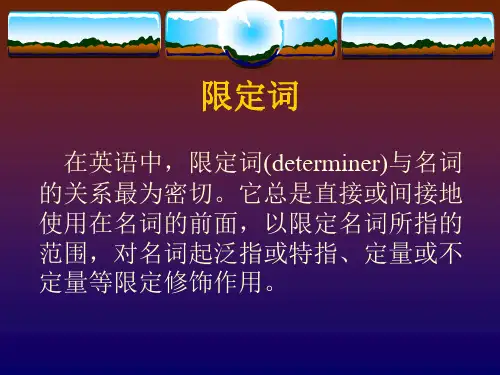
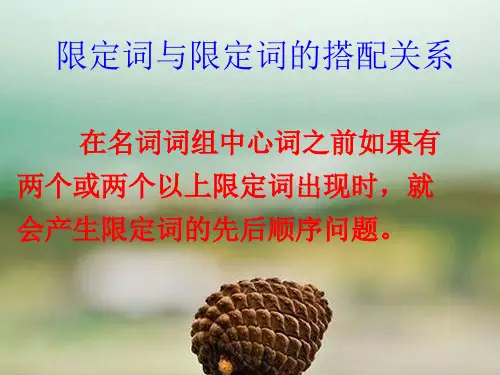
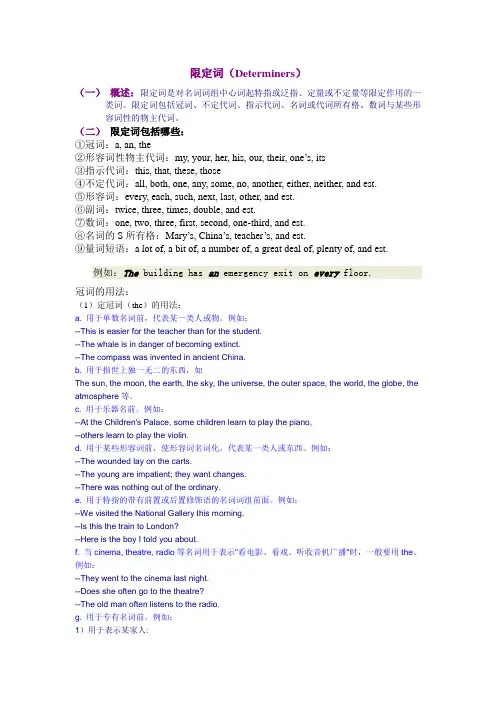
限定词(Determiners)(一)概述:限定词是对名词词组中心词起特指或泛指、定量或不定量等限定作用的一类词。
限定词包括冠词、不定代词、指示代词、名词或代词所有格、数词与某些形容词性的物主代词。
(二)限定词包括哪些:①冠词:a, an, the②形容词性物主代词:my, your, her, his, our, their, one’s, its③指示代词:this, that, these, those④不定代词:all, both, one, any, some, no, another, either, neither, and est.⑤形容词:every, each, such, next, last, other, and est.⑥副词:twice, three, times, double, and est.⑦数词:one, two, three, first, second, one-third, and est.⑧名词的S所有格:Mary’s, China’s, teacher’s, and est.⑨量词短语:a lot of, a bit of, a number of, a great deal of, plenty of, and est.例如:The building has an emergency exit on every floor.冠词的用法:(1)定冠词(the)的用法:a. 用于单数名词前,代表某一类人或物。
例如:--This is easier for the teacher than for the student.--The whale is in danger of becoming extinct.--The compass was invented in ancient China.b. 用于指世上独一无二的东西,如The sun, the moon, the earth, the sky, the universe, the outer space, the world, the globe, the atmosphere等。
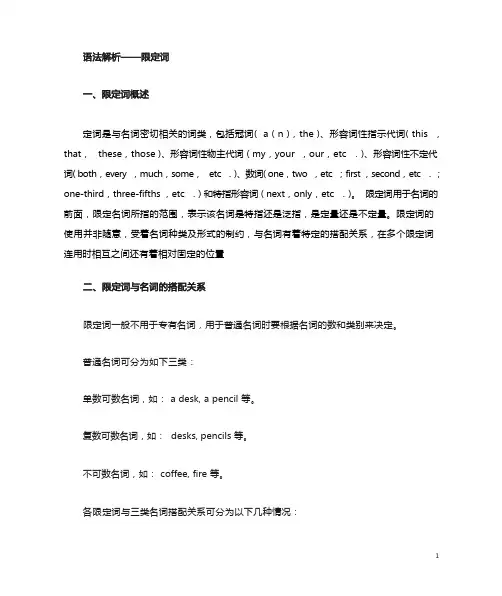
定词是与名词密切相关的词类,包括冠词( a ( n ),the )、形容词性指示代词( this ,that, these,those )、形容词性物主代词 ( my,your ,our,etc .)、形容词性不定代词( both,every ,much,some, etc .)、数词( one,two ,etc ;first ,second,etc .;one-third,three-fifths ,etc .) 和特指形容词 ( next,only,etc .)。
限定词用于名词的前面,限定名词所指的范围,表示该名词是特指还是泛指,是定量还是不定量。
限定词的使用并非随意,受着名词种类及形式的制约,与名词有着特定的搭配关系,在多个限定词连用时相互之间还有着相对固定的位置限定词一般不用于专有名词,用于普通名词时要根据名词的数和类别来决定。
普通名词可分为如下三类:单数可数名词,如: a desk, a pencil 等。
复数可数名词,如: desks, pencils 等。
不可数名词,如: coffee, fire 等。
各限定词与三类名词搭配关系可分为以下几种情况:A. 能与三类名词搭配的限定词定冠词 the, 如:the book, the books, the bread 等。
物主代词、名词所有格,如: my /John's book my /John's books my /John's breadall / some / any / no ,如: all / some / any / no book all / some / any / no booksall / some / any / no breadother / such ,如: other / such student other / such studentswh -words (eg. what, which, whose 等)。

定词是与名词密切相关的词类,包括冠词(a(n),the)、形容词性指⽰代词(this,that, these,those)、形容词性物主代词(my,your,our,etc.)、形容词性不定代词(both,every,much,some, etc.)、数词(one,two,etc;first,second,etc.;one-third,three-fifths,etc.)和特指形容词(next,only,etc.)。
限定词⽤于名词的前⾯,限定名词所指的范围,表⽰该名词是特指还是泛指,是定量还是不定量。
限定词的使⽤并⾮随意,受着名词种类及形式的制约,与名词有着特定的搭配关系,在多个限定词连⽤时相互之间还有着相对固定的位置。
⼀.限定词与名词的搭配关系名词有不可数名词、单数可数名词和复数可数名词之分,对限定词有不同的要求。
根据这种搭配关系可将限定词划分为以下⼏类:1.只能限定单数可数名词的限定词下列限定词只能⽤以限定单数可数名词:another,each,neither,either,the whole,every,a /an,one,例如:Neither road is very good.I spent the whole morning in bed today.2.只能限定复数可数名词的限定词下列限定词只能⽤以限定复数可数名词:both,(a)few,many,several,these, those,a couple of,a number of,例如:Both her parents are doctors.She has few friends.3.只能限定不可数名词的限定词下列限定词只能⽤以限定不可数名词:much,(a)little,a bit of,a great deal of, an amount of,例如:I have much pleasure in declaring this new factory open.There's been a bit of trouble at the office.4.既可限定不可数名词,⼜可限定单数可数名词和复数可数名词的限定词下列限定词既可限定不可数名词,⼜可限定单数可数名词和复数可数名词:all,any,half,my(your,our,etc.),no,the rest of,the same,some,such,what,which, whose,the,etc.,例如:He waited for half an hour.(限定单数可数名词)He has read half the books.(限定复数可数名词)He has eaten half the bread.(限定不可数名词)5.既可限定不可数名词,⼜可限定复数可数名词的限定词下列限定词既可限定不可数名词,⼜可限定复数可数名词:enough,more,most, plenty of,a quantity of,a lot of,lots of,less,例如:Have we got enough food?(限定不可数名词)We have enough seats for everyone.(限定复数可数名词)6.既可限定单数可数名词,⼜可限定复数可数名词的限定词下列限定词既可限定单数可数名词,⼜可限定复数可数名词: next,last,the other,first,second,etc.,例如:He was the last person to leave.(限定单数可数名词)We spent the last days of our holidays at home.(限定复数可数名词)7.既可限定不可数名词,⼜可限定单数可数名词的限定词下列限定词既可限定不可数名词,⼜可限定单数可数名词:this,that。
限定词以及不定限定词的具体⽤法搭配详解限定词(determiner)限定词是在名词词组中对名词中⼼词起特指、泛指、定量或不定量等限定作⽤的⼀类词。
⼀、英语限定词种类1.定冠词,不定冠词,零冠词。
如:the, a2.名词属格。
如:my friend’s, Tom’s…3.物主限定词。
如: my, your …4.指⽰限定词。
如:this, that, these, those, such…5.疑问限定词。
如:what, whose, which…6.关系限定词。
如:which, whose…7.不定限定词。
如:some, any, each, every, either, neither, all8.数词 (基数词、序数词、倍数词、分数词)9.量词。
如:a lot of, lots of , a great/good deal of ,a great/large/good number of …⼆、限定词与三类名词的搭配关系限定词按它词汇意义可分为特指限定词、泛指限定词、定量限定词、不定量限定词四⼤类。
这四类限定词有的能与单数、复数可数名词搭配,也可与不可数名词搭配1)能与三类名词搭配的限定词主要有:the; my, John’s, the old man’s…; some, any, no, all, other, such, what(ever), which (ever), whose…eg. the book----the books----the money,my book----my books----my moneyJohn’s book--- John’s books---- John’s money2) 能与单数名词搭配的限定词。
如:a (n) , each, every, another, either ,one, neither, many a, such a (n) …eg. each worker, every student,either book,another book3) 能与复数名词搭配的限定词。
首先需要理解的是,究竟什么是限定词?在英语中,限定词与名词的关系最为密切,因为它必然是修饰某个名词,以限定名词所指的范围,对名词的泛指,特指,定量或不定量起一个限定的作用。
限定词,就是对名词起限定作用的各类词的总称,限定词很多很多。
包括冠词,数词,指示代词,物主代词,不定代词,名词所有格等,这些都看作是限定词的范围.这里总结了一些限定词的用法,限定词的用法很繁琐,很麻烦的那种,需要有很大的耐心和毅力。
这些东西平时最好别看,没啥大用,只是做题的时候必须拿出来查查,题做多了,自然也就掌握了。
数量限定词(一):a few,few;a little,little一、与名词的搭配关系a few 和few后面只能接复数名词;如:a few days, few boysa little和little 后面只能接不可数名词如:a little water, little money二、肯定、否定的区别a few 和 a little 是肯定的,表示“有一些“的意思;few和little是否定的,表示”很少,几乎没有“.如:a few people can understand.有一些人能理解.few people can understand.没什么人能理解.I have little interest in English.我对英文没什么兴趣.I have a little interest in English.我对英文有一点兴趣。
三、搭配关系正确的搭配是Only a little;only a few;very few;very little,需要无条件记忆,也可以读熟练,靠语感.数量限定词(二):some 、any一、与名词的搭配关系Some 和any可以跟可数名词的复数,也可以跟不可数名词,表示“一些”。
Some一般用于肯定句,any用于否定和疑问句.疑问句特殊情况是,我们在期待一个正面的回答或鼓励对方说“是“的时候,要在疑问句中用some.如:Would you like to give me some advice?你愿意给我点建议吗?Can I have some more wine?我能在喝点酒吗?二、特殊用法1.Any与单数名词搭配这时候any的意思是“无论哪一个,任何一个”用于肯定句和否定句都行。
语法解析——限定词一、限定词概述定词是与名词密切相关的词类,包括冠词(a(n),the)、形容词性指示代词(this,that,these,those)、形容词性物主代词(my,your,our,etc.)、形容词性不定代词(both,every,much,some,etc.)、数词(one,two,etc;first,second,etc.;one-third,three-fifths,etc.)和特指形容词(next,only,etc.)。
限定词用于名词的前面,限定名词所指的范围,表示该名词是特指还是泛指,是定量还是不定量。
限定词的使用并非随意,受着名词种类及形式的制约,与名词有着特定的搭配关系,在多个限定词连用时相互之间还有着相对固定的位置二、限定词与名词的搭配关系限定词一般不用于专有名词,用于普通名词时要根据名词的数和类别来决定。
普通名词可分为如下三类:单数可数名词,如:a desk, a pencil等。
复数可数名词,如:desks, pencils等。
不可数名词,如:coffee, fire等。
各限定词与三类名词搭配关系可分为以下几种情况:A. 能与三类名词搭配的限定词定冠词the, 如:the book, the books, the bread等。
物主代词、名词所有格,如:my / John's book my / John's books my / John's breadall / some / any / no,如:all / some / any / no book all / some / any / no booksall / some / any / no breadother / such,如:other / such student other / such studentswh -words (eg. what, which, whose等)。
第五章限定词限定词(Determiner)是指冠词、物主代词、名词属格、指示代词、不定代词、数词等这一类词,用于名词前,对名词起特指或泛指作用,或表示定量或不定量意义。
有时一个名词可以同时被几个限定词修饰。
本章要讨论的是限定词修饰名词的一般规则以及几个限定词修饰名词时相互位置关系。
冠词的用法将在第六章专门讨论,本章不再涉及。
5.1 限定词修饰名词用法比较1. another, otheranother一般修饰单数可数名词,other一般修饰单复数可数名词。
例如:He couldn't get a job in this company, so he tried another company.他在这家公司找不到工作,于是到另一家公司试试。
Some pupils welcomed my decision, but other pupils felt unhappy about it.有的学生欢迎我的决定,但还有些学生感到不满。
注意“the other+名词”特指“两者中另一个”或“三者以上其余的”。
例如:The doctor told me to close one eye and look at things with the other eye.医生叫我闭上一只眼睛,用另一只眼睛看东西。
Only Hamlin reached the top of the hill, but the other climbers gave up halfway.只有汉姆林到达山顶,而其他登山队员半途放弃。
another还可以表示“类似的一个”。
例如:The doctor is regarded as another Bethune of our time.这个医生被看作我们时代的又一个白求恩。
2. either, neithereither, neither只能修饰单数可数名词。
either可以表示“两者中的每一方”,这时可以与each 互换使用。
第十四章限定词一、限定词概述定词是与名词密切相关的词类,包括冠词(a(n),the)、形容词性指示代词(this,that,these,those)、形容词性物主代词(my,your,our,etc.)、形容词性不定代词(both,every,much,some,etc.)、数词(one,two,etc;first,second,etc.;one-third,three-fifths,etc.)和特指形容词(next,only,etc.)。
限定词用于名词的前面,限定名词所指的范围,表示该名词是特指还是泛指,是定量还是不定量。
限定词的使用并非随意,受着名词种类及形式的制约,与名词有着特定的搭配关系,在多个限定词连用时相互之间还有着相对固定的位置二、限定词与名词的搭配关系限定词一般不用于专有名词,用于普通名词时要根据名词的数和类别来决定。
普通名词可分为如下三类:单数可数名词,如:a desk, a pencil等。
复数可数名词,如:desks, pencils等。
不可数名词,如:coffee, fire等。
各限定词与三类名词搭配关系可分为以下几种情况:A. 能与三类名词搭配的限定词定冠词the, 如:the book, the books, the bread等。
物主代词、名词所有格,如:my / John's bookmy / John's booksmy / John's breadall / some / any / no,如:all / some / any / no bookall / some / any / no booksall / some / any / no breadother / such,如:other / such studentother / such studentswh -words (eg. what, which, whose等)。
I'm sorry you had such terrible weather.Which John do you mean, John the baker or John the post man?Note:such经常与不定冠词连用构成such + a(n) + adj + 名词结构。
限定词限定词(DETERMINER〕是在名词词组中对名词中心词起特指(SPECIFIC REFERENCE〕、类指(GENERIC REF ERENCE〕以及表示确定数量(DEFINITE QUANTITY〕和非确定数量(INDEFINITE QUANTITY〕等限定作用的词类。
名词词组除有词汇意义外,还有其所指意义(REFERENTIAL MEANING〕,是特指(即指特写的对象〕,还是类指(即泛指一类人或物〕;是有确定的数量,还是没有确定的数量。
能在名词词组中表示这种所指意义的词类就是限定词。
英语的限定词包括:定冠词(DEFINTITE ARTICLE〕,不定冠词(INDEFINITE ARTICLE〕,零冠词(ZERO ARTICLE〕物主限定词(POSSESSIVE DETERMINER〕,my, your, his, her, our, your, their, one’s, its.名词属格(GENITIVE NOUN〕,John’s, my friend’s.指示限定词(DEMONSTRATIVE DETERMINER〕,this, that, these, those, such.关系限定词(RELATIVE DETERRMINER〕,whose, which.疑问限定词(INTERROGATIVE DETERMINER〕,what, which, whose.不定限定词(INDEFINITE DETERMINER〕,no, some, any, each, every, enough, either, neither, all, both, h alf, several, many, much, (a) few, (a) little, other, another.基数词(CARDINAL NUMERAL〕和序数词(ORDINAL NUMERAL〕倍数词(MULTIPLICATIVE NUMERAL〕和分数词(FRACTIONAL NUMERAL〕量词(QUANTIFIER〕a lot of, lots of, plenty of, a great of, a good deal of, a large of, a small amount of, a quantity of, a great of, a good number of等。
第十四章限定词一、限定词概述定词是与名词密切相关的词类,包括冠词(a(n),the)、形容词性指示代词(this,that,these,those)、形容词性物主代词(my,your,our,etc.)、形容词性不定代词(both,every,much,some,etc.)、数词(one,two,etc;first,second,etc.;one-third,three-fifths,etc.)和特指形容词(next,only,etc.)。
限定词用于名词的前面,限定名词所指的范围,表示该名词是特指还是泛指,是定量还是不定量。
限定词的使用并非随意,受着名词种类及形式的制约,与名词有着特定的搭配关系,在多个限定词连用时相互之间还有着相对固定的位置二、限定词与名词的搭配关系限定词一般不用于专有名词,用于普通名词时要根据名词的数和类别来决定。
普通名词可分为如下三类:单数可数名词,如:a desk, a pencil等。
复数可数名词,如:desks, pencils等。
不可数名词,如:coffee, fire等。
各限定词与三类名词搭配关系可分为以下几种情况:A. 能与三类名词搭配的限定词定冠词the, 如:the book, the books, the bread等。
物主代词、名词所有格,如:my / John's bookmy / John's booksmy / John's breadall / some / any / no,如:all / some / any / no bookall / some / any / no booksall / some / any / no breadother / such,如:other / such studentother / such studentswh -words (eg. what, which, whose等)。
I'm sorry you had such terrible weather.Which John do you mean, John the baker or John the post man?Note:such经常与不定冠词连用构成such + a(n) + adj + 名词结构。
如:I've never lived in such a large house as this before.They haven't had such a good time for ages.B. 只能与单数可数名词搭配的限定词如:a (n), each, every, either, one等。
I told every student to come.She knows every pupil of the class.You may use either hoe.C. 只能与复数可数名词搭配的限定词如:both, (a) few, several, these / those, a (great) number of, two / three, many等。
We're asking a few friends round to dinner.A great number of animals are killed every year.Note:many后面可以跟a (n)放在单数可数名词前,尽管还表示“许多”的意思,但动词用单数。
Many a man is going to welcome the foreign guests.Many a friend has been invited to this party.D. 只能与不可数名词搭配的限定词如:(a) little, a bit of, a great amount of, a great deal of, much 等。
In fact I know a bit of Spanish.A large amount of money is spent on tobacco every year.E. 能与单数可数名词和复数可数名词搭配的限定词如:the first / second, the next, the other 等。
What's the next thing to do?John wanted to know what the other doctors suggest.F. 能与复数可数名词和不可数名词搭配的限定词如:a lot of, plenty of, lots of, enough, more, most等。
There is enough food for everybody.There aren't enough tools to go around.G. 能与单数可数名词和不可数名词搭配的限定词如:(the) least, this, that等。
He hadn't the least thought of his own interests.She fainted at the least sight of blood.三、限定词与限定词的搭配关系在名词词组中,当两个以上的限定词同时出现时,限定词之间就存在前后顺序问题,根据限定词不同的搭配位置,限定词可分为中位限定词、前位限定词和后位限定词。
前位限定词(Predeterminers):all, both, half, double, twice; one third, two thirds等。
中位限定词(Central determiners )包括:冠词;指示词(this / that / these / those) ;形容词性物主代词,名词所有格(my, John's);量词(some, any, no, every, each, either, neither, enough, much等);wh-words (what, which, whose等)。
后位限定词(Postdeterminers):基数词;序数词; last, next, other, another等; such; many, little, few, several, more, less等。
The teacher asked his students to write their answers on every othe r line.老师要求学生隔一行写出答案。
Both my brothers have graduated from universities.我两个兄弟都大学毕业了。
The old men had a very good time during all these last few days.这些老人在最后一段日子里过得很愉快。
在限定词的搭配中,一般的顺序都是前位-中位-后位,中位限定词之间和前位限定词之间是互相排斥的,即:两个中位限定词或两个前位限定词不能同时修饰中心词-名词,而后位限定词则可以并列修饰中心词。
Mr Harrison showed us a few more samples.T om broke his leg on New Year's day. It took him the next few weeks to get over it.汤姆新年那天摔断了腿,几个星期后才恢复。
The girl's parents invited several hundred guests to her birthday party.女孩的父母邀请了几百名客人参加她的生日晚会。
Note:限定词使用规则:限定词的分类比较复杂、难记。
一般情况下,可以运用以下几条简单、实用的规则。
A.把all和both放在其他限定词之前。
如:The little boy ate all the food.All such problems should be considered.Both my hands were seriously hurt.B.把many / much, more / most, few / little放在其他限定词之后。
如:His many successes made him famous.John's few friends speak highly of him.With the surrender of the enemy troops, no more fighting was expected there.C.感叹句中,把what和such放在a(n)之前。
如:What a lovely girl!I've never seen such a crowd!四、几组限定词的用法比较(一)some, any, no的用法some, any, no同是能与单数可数名词、复数可数名词和不可数名词搭配的限定词。
1.some和any表示“一些,若干几分”等含义,一般情况下,some用于肯定句,any用于疑问、否定、条件句中。
Have you got any aspirins?Mr White has some flowers in his garden.We haven't invited any students to the party.If you want any glasses, I'll send you some.2.any 还可以用于实际上含否定意思的肯定句中。
例如,含有never, without, hardly等词的肯定句。
The young accountant seldom makes any error in his books.I can answer your questions without any hesitations.The noise of the party prevented me from getting any sleep.3.some可以与others连用。
Some people like the sea, others prefer the mountains.Some students answered Yes and others answered No.4.如果说话人预期肯定回答时,some也可用于疑问句。
Don't you give him some tickets?"I've just been shopping." "Oh, did you buy some rice?”some还可用在表示劝请、请求、命令的疑问句中。